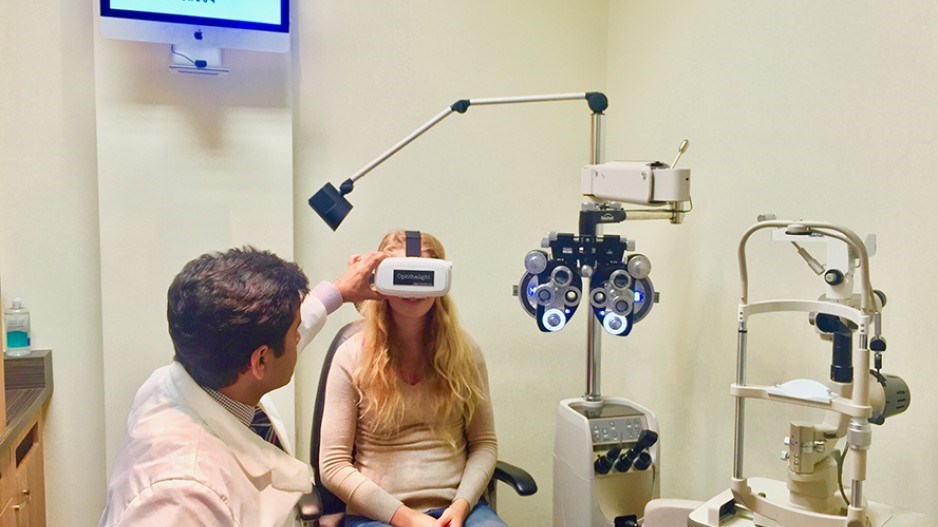Innovation spearheaded on the West Coast is earning accolades for two B.C. tech startups.
Vancouver-based Ophthalight Digital Solutions and Boost Environmental Systems were both honoured recently with the $5,000 Mitacs Global Impact Entrepreneur award for tackling niche issues in the health and environment sectors.
Mitacs is a non-profit organization that designs and delivers research and training programs across the country. The winners of this year’s prizes were evaluated for their ability to show sound business planning, entrepreneurial spirit and a commitment to innovation.
Ophthalight was recognized for its O-Glass, a headset that automatically checks for signs of eye disease, replacing the manual eye testing done by ophthalmologists.
Currently, when ophthalmologists do manual testing for eye diseases that affect the optical nerve, they stimulate the eyes with a flashlight to see how long it takes for the pupils to dilate and to observe the difference between the size of each pupil. If optic nerves are healthy, pupils contract the same amount when a flashlight is shone into one eye.
Changes in pupil size are often very small and the reaction speed is less than a second, so manual tests can easily be misinterpreted by ophthalmologists, said electrical engineer Yaser Roshan, who co-founded Ophthalight.
“Unless the difference is very huge, they can’t easily find small differences in different eyes, so they can’t acknowledge the small problems of the optic nerve in each eye.”
In a bid to improve testing accuracy, Roshan and Ophthalight co-founder Amir Vejdani, an ophthalmologist, began developing O-Glass three years ago. Looking like a virtual-reality headset, O-Glass slips over the eyes and automates the eye test, flashing a light for each eye while recording videos of both eyes at the same time. Test videos are then sent to the examiner’s computer.
Besides accuracy, Roshan said another major advantage is that it streamlines the process.
“It’s completely automated, so it doesn’t need any experienced ophthalmologist, which is not the same for manual eye tests. It can be used in remote areas with just a nurse or even a technician, who can use the device and send the results [to] the doctor. The doctor can just view the processed results and diagnose if there’s any problem or not.”
O-Glass is in the last stage of clinical trials and is due for market launch in the Middle East by September. It is expected to be in the Canadian market by winter. Overall, the cost of making the devices is about $1,500; cost for the user is expected to be around $4,500.
The Mitacs entrepreneur awards also paid tribute June 8 to Vancouver’s Boost Environmental Systems for its solution to the threat of groundwater pollution from large volumes of excess manure generated by enclosed dairy farms and sewage treatment plants.
Last year, four researchers from the University of British Columbia’s civil engineering department co-founded the company to commercialize their Impact manure filtering system.
A 2016 provincial government report notes that an average dairy farm in B.C. with 140 milking cows produces 6,300 tonnes of manure per year.
Dairy farmers’ traditional method of managing this manure is to spread it on agricultural land to fertilize feed crops. This is a good practice as long as farmers can maintain the balance of nutrients in the soil, said Boost Environmental Systems co-founder Asha Srinivasan.
But dairy farms run intensively on limited land, and dairy manure has a higher ratio of phosphate to nitrogen, leading to buildup of nutrients on the surface.
Srinivasan said excess nitrogen and phosphorus on the surface of the soil can contaminate groundwater.
While dairy farms typically have an on-site separator that splits dairy manure into liquid and solid forms, there’s still a high volume of solids in the liquid portion that can be broken down to manage manure more efficiently. Impact uses microwave heating and oxidants like hydrogen peroxide to filter the solids. All the nutrients found in the solid manure are released as a liquid. After being put through a digester, the liquid can produce energy as biogas or be converted to fertilizer.
Srinivasan said farmers can no longer continue to dump all their manure onto agricultural lands. “We need to have a change in the mindset and really think about other means of managing manure application, so that is where Impact comes into the picture.”
Excess manure is an issue for sewage treatment plants in the city as well. More than 54,000 tonnes of sewage manure was produced in 2015 in Greater Vancouver, according to a Metro Vancouver report. Sewage manure is difficult to get rid of because it has to meet rigid criteria to be used as fertilizer; otherwise it goes to a landfill. Through its filtering process, Srinivasan said, Impact can reduce sewage sludge by about 70%.
“We believe the immediate benefit will be for municipal sewage treatment plants because solid volume handling and disposal of solids is a huge expensive problem for them,” she said. “They have regulated requirements to meet, and their operation and maintenance costs toward solids management is quite huge.”
Demand for Impact’s sewage treatment has been especially high from China, she said.
“China has a growing population and increasing volume of sewage. Their commitment now to the environment [makes it] a good point in time for us to negotiate with some of the investors in China.”
The company expects to have Impact ready for commercial release in early 2019.




